Nankai University
Nankai University (NKU or Nankai; simplified Chinese: 南开大学; traditional Chinese: 南開大學; pinyin: Nánkāi Dàxué) is a public research university located in Tianjin, China. It is a member of the prestigious 985 and 211 group of universities and a Chinese Ministry of Education Class A Double First Class University.[2][3] It was founded in 1919,[4] by educators Yan Xiu and Zhang Boling.
南开大学 | |
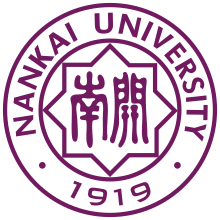 | |
| Motto | 允公允能,日新月异[1] |
|---|---|
Motto in English | Dedication to Public Interests, Acquisition of All-round Capability, Aspiration for Progress with Each Passing Day[1] |
| Type | National Public |
| Established | 1919 |
| President | Cao Xuetao |
Academic staff | 4,336 |
| Undergraduates | 13,076 |
| Postgraduates | 11,458 graduates |
| Location | , |
| Campus | urban |
| Colors | |
| Website | www |
During the Sino-Japanese War (1937–1945), Nankai University, Peking University and Tsinghua University merged and formed the National Changsha Provisional University, which later moved to Kunming and was renamed the National Southwestern Associated University (西南联大). It was described as The North Star of Higher Learning. On 25 December 2000, the State Ministry of Education signed an agreement with Tianjin Municipal Government to jointly establish and develop Nankai University. Since then, Nankai has been listed among the universities to receive priority development investments from the Chinese government in the twenty-first century.
Nankai has long been recognized as one of the most prestigious universities in China, constantly ranked among various top 10 lists of Chinese Universities.[5] As a comprehensive university with a wide range of disciplines, Nankai features a balance between the humanities and the sciences, a solid foundation and a combination of application and creativity. The university has 26 academic colleges, together with the Graduate School, the School for Continuing Education, the Advanced Vocational School, the Modern Distance Education School, and categories covering literature, history, philosophy, economics, management, law, science, engineering, agriculture, medicine, teaching and art. The university is especially well known for its economics, history, chemistry and mathematician researches and studies.[6]
Nankai's alumni include the first Premier of the People's Republic of China Zhou Enlai, mathematician Shiing-Shen Chern and Nobel laureates Chen Ning Yang and Tsung-Dao Lee.[7][8][9][10]
History

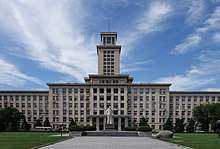
1919–1937
The university was founded as a private institution in 1919. Nankai's scale was relatively small at its inception partly because it received no funding from the government but instead was funded by foreign charitable funds and local entrepreneurs, with only 3 departments (liberal arts, science, and business) and 96 students. It was noted particularly for its courses which were taught in English using foreign curricula and textbooks.
The well-known Nankai Institute of Economics was established in 1927 and soon became one of the most prominent in China being the first non-foreign entity to calculate a Chinese Consumer Price Index.[11]
By 1937, Nankai had expanded into a university of 3 colleges, 13 departments, and 2 research institutes, with 429 students and 110 faculty and staff members.
It was compared to be "The North Star of Higher Learning".
1937–1949
In July 1937, during the Sino-Japanese War, Nankai campus was severely damaged by Japanese bombings.[12][13][14][15][16][17][18][19] About two-thirds of the school buildings were destroyed including its library which was deliberately burnt down by the Japanese Imperial Army. A number of the school's artifacts, including the university bell, were looted and remain in Japanese museums till this day.
In August 1937, still during the Sino-Japanese War, Nankai University, Peking University and Tsinghua University united together and formed the National Changsha Provisional University, which later moved to Kunming and was renamed the National Southwestern Associated University. In 1946, after the war, Nankai returned to Tianjin and was reformed into a national university by the government. At that time, Nankai had four schools (Liberal Arts, Science, Political Science and Economics, and Engineering) and 16 departments.
1949–1966
After the establishment of the People's Republic of China, Nankai was readjusted and became a comprehensive university with emphasis on the arts and sciences, with 14 departments and 3 professional specialties in total.
1966–1976
From 1966 to 1976 the School's normal life was out of order due to the Cultural Revolution. In 1976 a catastrophic earthquake broke out in Tangshan, bordering Tianjin, causing damage of varying degrees to the School's buildings.
1976–present

After 1980, Nankai added a number of new specialities and institutes. In Arts, applied specialities on financing were set up and the School of Economics was reopened in 1983, while in Sciences, interdisciplinary, marginal and high and new technological specialities were added.
Nankai was amongst the first universities in China to open its doors for students from America in the 1980s.[20] In 1989 the university was ordered by the Tianjin public security bureau to send two Americans back home, following rising political tensions over pro-democracy demonstrations.[21]
By the late 1980s, Nankai University had grown to be a comprehensive university embracing Humanities, Natural Sciences, Applied Sciences, Life Sciences, Managements and Art.
In 1994 Tianjin Foreign Trade College was merged to Nankai university. In 1999 under the combined efforts of Nankai and TEDA, TEDA College was set up. In 2000 the State Ministry of Education signed an agreement with Tianjin Municipal Government on jointly establishing and developing Nankai University. Experimental cooperation between Nankai University and Tianjin University was initiated on the principle of independent school-running and close cooperation. In 2002 under the cooperative efforts of Nankai, Government of Shenzhen and UC Berkeley, the Financial Engineering College was established in Shenzhen.
In May 2006 Nankai's president Rao Zihe tendered 15 of the 21 university's college dean positions, restaffing key positions in an effort to further improve the university's educational programs.[22]
In February 2015, following Chinese media reports and statements from inside the Chinese Communist Party that universities would have to "be cleansed of liberal Western textbooks and other ideological heresies" , Nankai's president Gong Ke publicly stated: "Recently I've read people on the Internet saying that the ranks of academics must be cleansed, purified and rectified. I can't agree with this. This was the mentality of 1957 or 1966." and "We cannot re-enact this history of "leftist" errors against intellectuals."[23][24]
 Yingshuidao Campus of NKU
Yingshuidao Campus of NKU TEDA college of NKU
TEDA college of NKU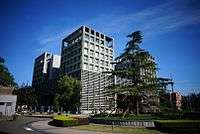 Joint Research Building of Tianjin University and NKU
Joint Research Building of Tianjin University and NKU Cemetery of Shiing-shen Chern
Cemetery of Shiing-shen Chern Siyuan building
Siyuan building
Campus
Nankai university encompasses three campuses. Balitai, Jinnan and TEDA.[25] The total local campus area is 456.1 and the building area 136.8 hectare.[26]
Balitai campus
Balitai was the first campus to be established in 1919 and is located at Balitai in the Nankai district of Taijin. The campus hosts 10 colleges, namely the Business School, School of Economics, School of Literature, College of Chemistry, School of Mathematical Sciences, Institute of Physics, College of Foreign Languages, College of Life Sciences and Institute of Japan Studies.
Jinnan campus
Jinnan campus is the latest campus of Nankai university. It was opened in September 2015 and is located in the Binhai New Area. The campus hosts 14 colleges, the Zhou Enlai School of Government, College of Tourism and Service Management, School of Medicine, College of Pharmacy, Law School, College of Chinese Language and Culture, Faculty of Philosophy, College of History, College of Computer and Control Engineering, College of Electronic Information and Optical Engineering, School of Material Science and Engineering, School of Finance and College of Software.
TEDA Campus
TEDA campus is also located in the Binhau New Area and hosts the TEDA Institute of Biological Sciences and Biotechnology and the TEDA Institute of Applied Physics.
Academics

Nankai is a multidisciplinary university under the jurisdiction of the Ministry of Education.
Teaching and Learning
The university has academic programs that cover the humanities, natural sciences, technology, life sciences, medical sciences and the arts, with an equal balance between the sciences and the liberal arts.
Nankai's academic programs operate on a semester calendar, with two terms. The first beginning in early September and ending in early January and the second beginning in early February and ending in early July. Subsequently, winter break usually ranges from early January to early February and summer break from early July to early September.[27]
Nankai, in 2013, had 22 colleges and schools, and offered 79 bachelor's degree programs, 231 master's degree programs, and 172 PhD programs. The total enrollment stood at approximately 12,000 undergraduate students and 11,000 graduate students. Of the total student population, 10% were international students from different countries around the world.
In 2018 the university offered a total of 80 undergraduate programs, 231 Master and 172 PhD programs and 28 post doctoral research stations. The total count of full-time students was 24,525. Academic staff consisted of 1,986 full-time teaching personnel, with 214 professors and 805 associate professors.[26]
Nankai offers different scholarships, among them the Chinese Government Scholarship for international students,[28] the CSC Scholarship for American Students,[29] the Tianjin Government Scholarship,[30] the Confucius Institute Scholarship[31] and the Nankai University Scholarship.[32]
Nankai also offers several scholarship programs to support international exchanges and hosts different international student exchange programs.[33] Nankai's broad international programs are organized through the International Office. The university has established cooperations with more than 300 international universities and academic institutions, including programs like an Elementary School Chinese Program with schools in the US, which was launched in 2009.[34][35][36][37] In 2010 the US-China exchange program Study International was launched, with the plan to send 100,000 American students to china in a four-year time frame. The first students were send to Nankai university in the fall of 2010.
In 2012 Nankai was invited to become the 35th member of The Global University Leaders Forum (GULF), a global community of high-ranking universities, including renown members like Yale University, Harvard University and the University of Oxford.[38]
Department rankings
Nankai's mathematics, chemistry, history, business and economics programs are among the best in China.
The chemistry research was ranked No. 1 according to the statistics from the Ministry of Education in 2008. Economics, mathematics and history were ranked 2nd among over 2000 Chinese universities.
Chern, Shiing-Shen established the world's largest mathematics institute (in terms of office area) in Nankai University.
The university is also highly regarded for its top quality undergraduate programs. Many of the undergraduate lectures are selected as national elite lectures by the Higher Education Division of the Ministry of Education.
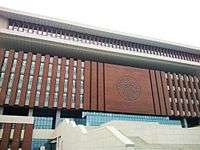
Research
The University has established broad international exchanges and collaborative relationships with more than 200 universities and academic institutions. Nobel Laureates Chen Ning Yang, Tsung-Dao Lee, Samuel Chao Chung Ting, Robert A. Mundell, and Reinhard Selten as well as former President of Korea Kim Dae Jung and former US Secretary of State Henry Kissinger were all conferred Honorary Professorships by Nankai University.[39]
In November 2016 Robert F. Engle, who won the 2003 Nobel Prize in economics, became an honorary professor at Nankai.[40]
Many other world-known scholars and entrepreneurs have been invited as Visiting Professors at Nankai University. Dr. Heng-Kang Sang returned from the United States to found the College of Economic and Social Development in 1987. Nankai University, a magnet for talented mathematicians known both at home and abroad, has become one of the most famous centers for mathematics worldwide.
Nankai established nine Confucius Institutes around the world.
Scientists from Nankai have been involved in different scientific breakthroughs and important advancements.[41][42][43]
Student life
Student body
In 2018 Nankai enrolled 24,525 full-time students, with 13,067 undergraduate, 8,162 postgraduate and 3,296 PhD students. Of them 1,902 were international students.
Colleges and schools
|
|
 College of Chemistry
College of Chemistry TEDA college of NKU
TEDA college of NKU School of Medicine
School of Medicine School of Finance
School of Finance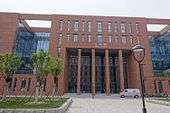 School of Law
School of Law
People
Presidents
- Zhang Boling: 1919–48
 The universities first president Zhang Boling
The universities first president Zhang Boling - He Lian (Franklin Ho): 1948–57 (acting)
- Yang Shixian: 1957–69
- vacant due to the Cultural Revolution: 1969–78
- Zang Boping: 1978
- Yang Shixian (second term): 1979–81
- Teng Weizao: 1981–86
- Mu Guoguang: 1986–95
- Hou Zixin: 1995–2006
- Rao Zihe: 2006–2011
- Gong Ke: 2011–2018
- Cao Xuetao: 2018–
Notable alumni
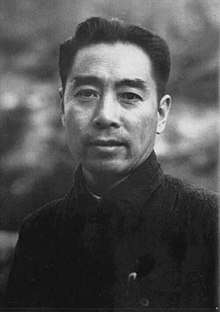
Notable alumni of Nankai university include
- Wang Anshun, Chinese politician and former mayor of Beijing
- Jerome Chen, Chinese historian and fellow of the Royal Society of Canada[44]
- Shiing-Shen Chern, Chinese mathematician regarded as a leader in geometry and one of the greatest mathematicians of the twentieth century[45]
- Chow Chung-cheng, Chinese artist and author
- Zhou Enlai, Chinese politician and first Premier of the People's Republic of China[46][47]
- Tsung-Dao Lee, Chinese-American physicist and winner of the Nobel Prize in Physics in 1957 (together with Chen-Ning Yang)[48]
- Ray Huang, Chinese philosopher and historian
- Li Jinyuan, Chinese businessman and billionaire
- David X. Li, Chinese statistician
- Guo Shuqing, Chinese politician, banker and formerly served as the Governor and Deputy Party Secretary of Shandong province, chairman of the China Securities Regulatory Commission (CSRC)
- Wu Ta-You, Chinese atomic and nuclear theoretical physicist who worked in the United States, Canada, mainland China and Taiwan and has been dubbed the "Father of Chinese Physics"
- Zhang Wenzhong, Chinese businessman and scholar
- Liu Xinyuan, Chinese molecular biologist
- Ren Xuefeng, Chinese politician and business executive who served as the Communist Party Secretary of Guangzhou and the Deputy Communist Party Secretary of Guangdong province
- Cao Yu, Chinese playwright, often regarded as China's Shakespeare and one of the most important playwrights of the 20th century[49][50]
- Chen-Ning Yang, Chinese physicist and winner of the Nobel Prize in Physics in 1957 (together with Tsung-Dao Lee)[51][48]
- Dou Yupei, Chinese politician and former Vice Minister of Civil Affairs
- Xiaowen Zeng, Chinese-Canadian author
A more extensive list of Nankai alumni can be found here.
Rankings
| University rankings | |
|---|---|
| Global – Overall | |
| ARWU World[52] | 301–400 |
| QS World[53] | 344 |
| Regional – Overall | |
| QS Asia[54] | 61 |

Nankai University is ranked among the top 10 universities in China, with exceptions in 2017 and 2018.[9] In the ranking of top 50 universities in China published by Renmin University of China in June 2011, it was ranked 10th.[7] In the Netbig ranking of 2011 it was ranked 10th as well.[8] In the QS World University Rankings of 2013 it was ranked 62nd among Asian universities, and 11th in China.[9] In the Chinese first-class university ranking of 2012 by Wu Shulian of China Management Academy, it was placed 8th.[10] In the CWTS Leiden Ranking 2013, it was ranked 53rd among world universities, and 1st in China.[55] In the Nature Index Global 2014, it was ranked 83rd among world universities, and 7th in China.[56]
References
- "NKU Motto". Retrieved 19 July 2018.
- "Nankai University". China Admissions. Retrieved 25 July 2020.
- "教育部 财政部 国家发展改革委 关于公布世界一流大学和一流学科建设高校及建设 学科名单的通知 (Notice from the Ministry of Education and other national governmental departments announcing the list of double first class universities and disciplines)".
- "Nankai University, Tianjin, China - Listing by Bizpages". bizpages.org. Retrieved 1 May 2020.
- "Nankai University". China Admissions. Retrieved 25 July 2020.
- "学校简介". Nankai University. Retrieved 25 July 2020.
- "Renmin University of China Higher Education Research". plan.ruc.edu.cn (in Chinese). Retrieved 6 July 2011.
- "Netbig 2011 Chinese University Ranking". rank2011.netbig.com (in Chinese). Archived from the original on 28 June 2011. Retrieved 6 July 2011.
- "QS World University Rankings". topuniversities.com. Retrieved 2013. Check date values in:
|accessdate=(help) - "List of the first-class Chinese Universities 2012". qq.com. Retrieved 3 February 2012.
- http://www.nankai.edu.cn/english/
- China Information Service (1938). Bulletin. p. 28.
- Epstein, Israel (1939). The people's war. V. Gollancz. p. 51.
- Epstein, Israel (2005). My China Eye: Memoirs of a Jew and a Journalist. Long River Press. pp. 69–. ISBN 978-1-59265-042-2.
- The China Magazine. Chinese News Service. 1946. p. 25.
- China Magazine. Chinese News Service. 1946. p. 25.
- Shih, Hu (1 February 2013). English Writings of Hu Shih: Literature and Society. Springer Science & Business Media. pp. 164–. ISBN 978-3-642-31184-0.
- Winchester, Simon (25 September 2008). Bomb, Book and Compass: Joseph Needham and the Great Secrets of China. Penguin UK. pp. 65–. ISBN 978-0-14-188989-4.
- Richard J. Meyer (2009). Jin Yan: The Rudolph Valentino of Shanghai. Hong Kong University Press. pp. 66–. ISBN 978-962-209-586-1.
- "New York Times: China opens up to Americans". Retrieved 19 July 2018.
- "New York Times: Beijing orders 2 more Americans to Leave China". Retrieved 19 July 2018.
- Xin, Hao; Normile, Dennis (11 January 2008). "Gunning for the Ivy League". Science. 319 (5860): 148–151. doi:10.1126/science.319.5860.148. ISSN 0036-8075. PMID 18187632.
- Buckley, Chris. "University President Sees Echoes of Cultural Revolution in New Campaign". Sinosphere Blog. Retrieved 19 July 2018.
- Buckley, Chris. "Chinese President Returns to Mao's (and His) Roots in Yan'an". Sinosphere Blog. Retrieved 19 July 2018.
- "NKU Campus". Retrieved 19 July 2018.
- "Facts and Figures". nankai.en.school.cucas.cn. Retrieved 19 July 2018.
- "NKU Academic Calendar". Retrieved 19 July 2018.
- "Chinese Government Scholarship". Retrieved 18 July 2018.
- "CSC Scholarship for American Students". Retrieved 18 July 2018.
- "Tianjin Government Scholarship". Retrieved 18 July 2018.
- "Confucius Institute Scholarship". Retrieved 18 July 2018.
- "Nankai University Scholarship". Retrieved 18 July 2018.
- "NKU Student Exchange". Retrieved 18 July 2018.
- Pomfret, John (27 July 2008). "A Long Wait at the Gate to Greatness". ISSN 0190-8286. Retrieved 19 July 2018.
- Hill, David (27 August 2009). "Elementary School Expands Chinese Program". ISSN 0190-8286. Retrieved 19 July 2018.
- "NKU Overview exchange programs". Retrieved 18 July 2018.
- "NKU partners". Retrieved 18 July 2018.
- "NKU International Organizations". Retrieved 18 July 2018.
- "NKU Scholars". Retrieved 18 July 2018.
- 冯紫煜. "Nobel prize winner to educate students in Tianjin". www.chinadaily.com.cn. Retrieved 19 July 2018.
- "Financial Times: Worth Watching (Liquorice Cancer Care)". Retrieved 19 July 2018.
- "The Washington Post: What's Not to Like About a Graphene Spacecraft?". Retrieved 19 July 2018.
- "Talk about mind control: Chinese develop a car operated by brain waves". Washington Post. Retrieved 19 July 2018.
- "FELLOWS DIRECTORY | The Royal Society of Canada". rsc-src.ca. Retrieved 30 August 2018.
- Hitchin, N. J. (13 August 2014). "Shiing-Shen Chern. 26 October 1911 – 3 December 2004". Biographical Memoirs of Fellows of the Royal Society. 60: 75–85. doi:10.1098/rsbm.2014.0018. ISSN 0080-4606.
- Lelyveld, Joseph. "New York Times: In China, It's Politics by Allegory". Retrieved 19 July 2018.
- ""Zhou Enlai Class" Named in Nankai University". en.people.cn. Retrieved 12 July 2018.
- "The Nobel Prize in Physics 1957". www.nobelprize.org. Retrieved 12 July 2018.
- "Welcome to drama". 18 April 2006. Archived from the original on 18 April 2006. Retrieved 12 July 2018.
- Chen, Xiaomei (1 April 2014). The Columbia Anthology of Modern Chinese Drama. Columbia University Press. ISBN 9780231165020.
- "Scientists give up US nationality to become Chinese citizens". South China Morning Post. Retrieved 12 July 2018.
- Academic Ranking of World Universities 2017
- QS World University Rankings 2018
- QS Asian University Rankings 2018
- "Leiden Ranking". Universiteit Leiden Centre for Science and Technology Studies. Retrieved 19 August 2013.
- "Nature Index Global 2014". Nature. Nature Publishing Group. 515 (7526): S98–S108. 2014. doi:10.1038/515S98a. PMID 25390156.
External links
| Wikimedia Commons has media related to Nankai University. |
